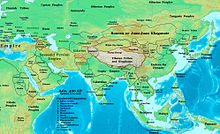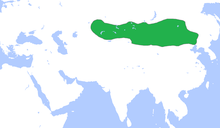This is an old revision of this page, as edited by 182.160.3.227 (talk) at 07:06, 6 July 2015. The present address (URL) is a permanent link to this revision, which may differ significantly from the current revision.
Revision as of 07:06, 6 July 2015 by 182.160.3.227 (talk)(diff) ← Previous revision | Latest revision (diff) | Newer revision → (diff)| Rouran Khaganate | |||||||||||||
|---|---|---|---|---|---|---|---|---|---|---|---|---|---|
| 330–555 | |||||||||||||
 | |||||||||||||
| Status | Khaganate | ||||||||||||
| Capital | Mumo city, Orkhon River, Mongolia | ||||||||||||
| Religion | Shamanism Buddhism | ||||||||||||
| Khagan | |||||||||||||
| • 330 | Yùjiǔlǘ Mùgǔlǘ | ||||||||||||
| • 555 | Yujiulü Dengshuzi | ||||||||||||
| Legislature | Kurultai | ||||||||||||
| Historical era | 1st millennium | ||||||||||||
| • Established | 330 | ||||||||||||
| • Disestablished | 555 | ||||||||||||
| Area | |||||||||||||
| 405 | 4,000,000 km (1,500,000 sq mi) | ||||||||||||
| |||||||||||||
| Today part of | |||||||||||||
Template:Alternative names Template:Alternative names
Rouran, Nirun Khaganate(Template:Lang-mn, Nirun; ~human's back, the name origin similar to Alan Gua's myth; Chinese: 柔然; pinyin: Róurán; lit. 'soft-like'), Ruru/Ruru (Chinese: 蠕蠕/茹茹; pinyin: Rúrú/Rúrú; Wade–Giles: Juan-juan/Ju-ju; lit. 'wriggling insects/fodder'), or Tan Tan (Chinese: 檀檀; pinyin: Tántán; Wade–Giles: T'an-t'an) was the name of a state of nomadic Proto-Mongols in Mongolia from the late 4th century until the middle 6th century. It has sometimes been hypothesized that the Rouran are identical to the Pannonian Avars who later appeared in Europe.
The term Rouran is a Mandarin Chinese transcription of the pronunciation of the name the confederacy used to refer to itself. Ruanruan and Ruru remained in modern usage despite once being derogatory. They derived from orders given by the Emperor Taiwu of Northern Wei (Tuoba), who waged war against the Rouran and intended to intimidate the confederacy.
The power of the Rouran was broken by an alliance of Göktürks, Tuoba's Northern Qi and Northern Zhou dynasties and tribes in Central Asia in 552.
Origin and expansion
The Rouran were a confederation led by Xianbei people who remained in the Mongolian steppes after most Xianbei migrated south to Northern China and set up various kingdoms. They considered that Tuoba and Rourans descended from common ancestors. Also historian of the Northern Wei noted that Rourans descended from Xianbei. They were first noted as having defeated the Tiele and establishing an empire extending all the way to the Hulun, in eastern Inner Mongolia.
Mùgǔlǘ or Mugulyui was ancestor of the Rouran kings and Emperor of Northern Wei gave him name "Joujan". Book of Wei links Rourans with Mongolic Donghu people: "Joujan is descendant of the Dongu, and his family is Yùjiǔlǘ".
During the reign of Yujiulü Shelun king (402-410) Rouran became powerful empire.
To the west of the Rouran was a horde known in the west as the Hephthalite Empire (408–670) who originally, until the beginning of the 5th century, were a vassal horde of the Rouran.
Between Hephthalites and Rourans were also close contacts, although they had different languages and cultures, and Hephthalites borrowed much of their political organization from Rourans. In particular, the title “Khan“, which according to McGovern was original to the Rourans, was borrowed by the Hephthalite rulers. The reason for the migration of the Hephthalites southeast was to avoid a pressure of the Rourans. Further, the Hephthalites defeated the Yuezhi in Bactria and their leader Kidara led the Yuezhi to the south.
According to "Book of Song" (section Joujan), "Joujan's (Rouran) another name was "Tatar" or "Tartar", and they were Xiongnu's tribe".
The Rouran controlled the area of Mongolia from the Manchurian border to Turpan and, perhaps, the east coast of Lake Balkhash, and from the Orkhon River to China Proper. Their ancestor Mugulu is said to have been originally a slave of the Tuoba tribes, situated at the north banks of Yellow River Bend. Mugulu's descendant Yujiulü Shelun is said to be the first chieftain who was able to unify the Rouran tribes and to found the power of the Rouran by defeating the Tiele and Xianbei. Shelun was also the first of the steppe peoples to adopt the title of khagan (可汗) in 402, originally a title of Xianbei nobility.
The Rouran Khaganate arranged for one of their princesses, Khagan Yujiulü Anagui's daughter Princess Ruru to be married to the Han Chinese ruler Gao Huan of the Eastern Wei.
The Rouran and the Hephthalites had a falling out and problems within their confederation were encouraged by Chinese agents. In 508, the Tiele defeated the Rouran in battle. In 516, the Rouran defeated the Tiele. Within the Rouran confederation was a Turkic tribe noted in Chinese annals as the Tujue. After a marriage proposal to the Rouran was rebuffed, the Tujue joined with the Western Wei, successor state to the Northern Wei, and revolted against the Rouran. In 555, they beheaded 3,000 Rouran. Some scholars claim that the Rouran then fled west across the steppes and became the Avars, though many other scholars contest this claim. The remainder of the Rouran fled into China, were absorbed into the border guards, and disappeared forever as an entity. The last Rouran khagan fled to the court of Western Wei, but at the demand of Tujue, Western Wei executed him and the nobles that accompanied him.



Little is known of the Rouran ruling elite, which the Book of Wei cited as an offshoot of the Xianbei. The Rouran subdued modern regions of Xinjiang, Mongolia, Central Asia, and parts of Siberia and Manchuria from the late 4th century. Their frequent interventions and invasions profoundly affected neighboring countries. Though they admitted the Ashina of Göktürks into their federation, the power of the Rouran was broken by an alliance of Göktürks, the Chinese Northern Qi and Northern Zhou dynasties and tribes in Central Asia in 552. The Northern Wei, for instance, established the Six Garrisons bordering the Rouran, which later became the foci of several major mutinies in the early 6th century.
Khaghans of the Rouran
The Rourans were the first people who used the titles Khagan and Khan for their emperors (which are, therefore, assumed to be Mongolic in origin), replacing the Chanyu of the Xiongnu, whom Grousset and others assume to be Turkic.
Mongolian historian G.Sükhbaatar restored Mongol name of the Rouran kings.
| Temple names | Regal names | Family names and given name | Durations of reigns | Era names and their according durations |
Modern Mongolian pronunciation |
|---|---|---|---|---|---|
| Yùjiǔlǘ Mùgǔlǘ (郁久閭木骨閭) | 4th century | Mugului | |||
| Yùjiǔlǘ Chēlùhuì (郁久閭車鹿會) | 4th century | Charugui | |||
| Yùjiǔlǘ Tǔnúgūi (郁久閭吐奴傀) | 4th century | Tonogoi | |||
| Yùjiǔlǘ Bátí (郁久閭跋提) | 4th century | Butai | |||
| Yùjiǔlǘ Dìsùyuán (郁久閭地粟袁) | 4th century | ||||
| Yùjiǔlǘ Pǐhóubá (郁久閭匹侯跋) | 4th century | Bitubat | |||
| Venheti | 4th century | Ongudai (similar to the name of Ongud tribe) | |||
| Yùjiǔlǘ Màngētí (郁久閭縵紇提) | 4th century | ||||
| Yùjiǔlǘ Héduōhàn (郁久閭曷多汗) | 4th century | ||||
| Qiudoufa Khan (丘豆伐可汗) | Yùjiǔlǘ Shèlún (郁久閭社崙) | 402–410 | Jarun | ||
| Aikugai Khan (藹苦蓋可汗) | Yùjiǔlǘ Húlǜ (郁久閭斛律) | 410–414 | Höhlüd | ||
| Mouhanheshenggai Khan (牟汗紇升蓋可汗) (Bukha Yesunggei Khaan) |
Yùjiǔlǘ Dàtán (郁久閭大檀) | 414–429 | Tatar (similar to the name of Tatar confederation) | ||
| Chilian Khan (敕連可汗) | Yùjiǔlǘ Wútí (郁久閭吳提) | 429–444 | Engüdei | ||
| Chu Khan (處可汗) | Yùjiǔlǘ Tǔhèzhēn (郁久閭吐賀真) | 444–450 | Togochin | ||
| Shouluobuzhen Khan (受羅部真可汗) | Yùjiǔlǘ Yúchéng (郁久閭予成) | 450–485 | Yongkang Yǒngkāng (永康) 464–484 | Ijin | |
| Fumingdun Khan (伏名敦可汗) | Yùjiǔlǘ Dòulún (郁久閭豆崙) | 485–492 | Tàipíng (太平) 485–491 | Tülün | |
| Houqifudaikezhe Khan (侯其伏代庫者可汗) | Yùjiǔlǘ Nàgài (郁久閭那蓋) | 492–506 | Tàiān (太安) 492–505 | Nagai | |
| Tuohan Khan (佗汗可汗) (Toghon Khaan) | Yùjiǔlǘ Fútú (郁久閭伏圖) | 506–508 | Shǐpíng (始平) 506–507 | Bogd (similar to the name of Bogd Khan) | |
| Douluofubadoufa Khan (豆羅伏跋豆伐可汗) | Yùjiǔlǘ Chǒunú (郁久閭醜奴) | 508–520 | Jiànchāng (建昌) 508–520 | Chunu (similar to the name of Chonos tribe) | |
| Chiliantoubingdoufa Khan (敕連頭兵豆伐可汗) | Yùjiǔlǘ Ānàgūi (郁久閭阿那瓌) | 520–552 | Amgai | ||
| Mi'oukeshegou Khan (彌偶可社句可汗) | Yùjiǔlǘ Póluómén (郁久閭婆羅門) | 521–524 | Brahman (Hindu word) | ||
| Yùjiǔlǘ Tiěfá (郁久閭鐵伐) | 552–553 | Tibed | |||
| Yùjiǔlǘ Dēngzhù (郁久閭登注) | 553 | ||||
| Yùjiǔlǘ Kāngtí (郁久閭康提) | 553 | ||||
| Yùjiǔlǘ Ānluóchén (郁久閭菴羅辰) | 553–554 | Amarjin | |||
| Yùjiǔlǘ Dèng Shūzǐ (郁久閭鄧叔子) | 555 | ||||
References
- Rein Taagepera "Size and Duration of Empires: Growth-Decline Curves, 600 B.C. to 600 A.D.", Social Science History Vol. 3, 115-138 (1979)
- Jonathan M. Adams, Thomas D. Hall and Peter Turchin (2006). East-West Orientation of Historical Empires.Journal of World-Systems Research (University of Connecticut). 12 (no. 2): 219–229.
- History of Gobi Region
- Zhang, Min. Lun Beiwei Changcheng Junzheng Fangwei Tixi De Jianli ("On the Defensive System of Great Wall Military Town of Northern Wei Dynasty") China’s Borderland History and Geography Studies, Jun. 2003 Vol. 13 No. 2. Page 15.
- ^ West, Barbara A. (2008). Encyclopedia of the Peoples of Asia and Oceania. Infobase Publishing. p. 687. ISBN 978-0-8160-7109-8. Retrieved 26 May 2011.
- Findley (2005), p. 35.
- Hyacinth (Bichurin), Collection of information on peoples lived in Central Asia in ancient times, 1950. p.209
- Grousset (1970), p. 67.
- ^ A.Kurbanov "THE HEPHTHALITES-ARCHAEOLOGICAL AND HISTORICAL ANALYSIS" 2010
- eds. Lee, Stefanowska, Wiles 2007, p. 316.
- Gao Huan, as demanded by Yujiulü Anagui as one of the peace terms between Eastern Wei and Rouran, married the Princess Ruru in 545, and had her take the place of Princess Lou as his wife, but never formally divorced Princess Lou. After Gao Huan's death, pursuant to Rouran customs, the Princess Ruru became married to Gao Huan's son Gao Cheng, who also, however, did not formally divorce his wife.
- Grousset (1970), pp. 61, 585, n. 91.
- G.Sukhbaatar, Mongolian history sourcebooks, 1991
Sources
- Findley, Carter Vaughn. (2005). The Turks in World History. Oxford University Press. ISBN 0-19-516770-8 (cloth); ISBN 0-19-517726-6 (pbk).
- Grousset, René. (1970). The Empire of the Steppes: a History of Central Asia. Translated by Naomi Walford. Rutgers University Press. New Brunswick, New Jersey, U.S.A.Third Paperback printing, 1991. ISBN 0-8135-0627-1 (casebound); ISBN 0-8135-1304-9 (pbk).
- Map of their empire
- Definition
- information about the Rouran
- Kradin, Nikolay. "From Tribal Confederation to Empire: the Evolution of the Rouran Society". Acta Orientalia Academiae Scientiarum Hungaricae, Vol. 58, No 2 (2005): 149-169.
Categories:
